BSBFIM801: Manage Financial Resources Report - Principles & Methods
VerifiedAdded on 2022/12/27
|8
|1688
|45
Report
AI Summary
This report, focused on BSBFIM801 Manage Financial Resources, provides an overview of essential financial concepts. It begins by explaining accounting principles such as accrual, conservatism, and cost. The report then delves into financial statements, outlining principles for income statements, balance sheets, and cash flow statements, including rules for different entities. Communication processes and methods, including written, oral, nonverbal, and visual communication, are described as best practices. The report also touches upon compliance requirements and legislative responsibilities. Finally, it explains the cost of capital and working capital, providing a comprehensive understanding of financial resource management.

BSBFIM801 Manage financial resources
Paraphrase This Document
Need a fresh take? Get an instant paraphrase of this document with our AI Paraphraser

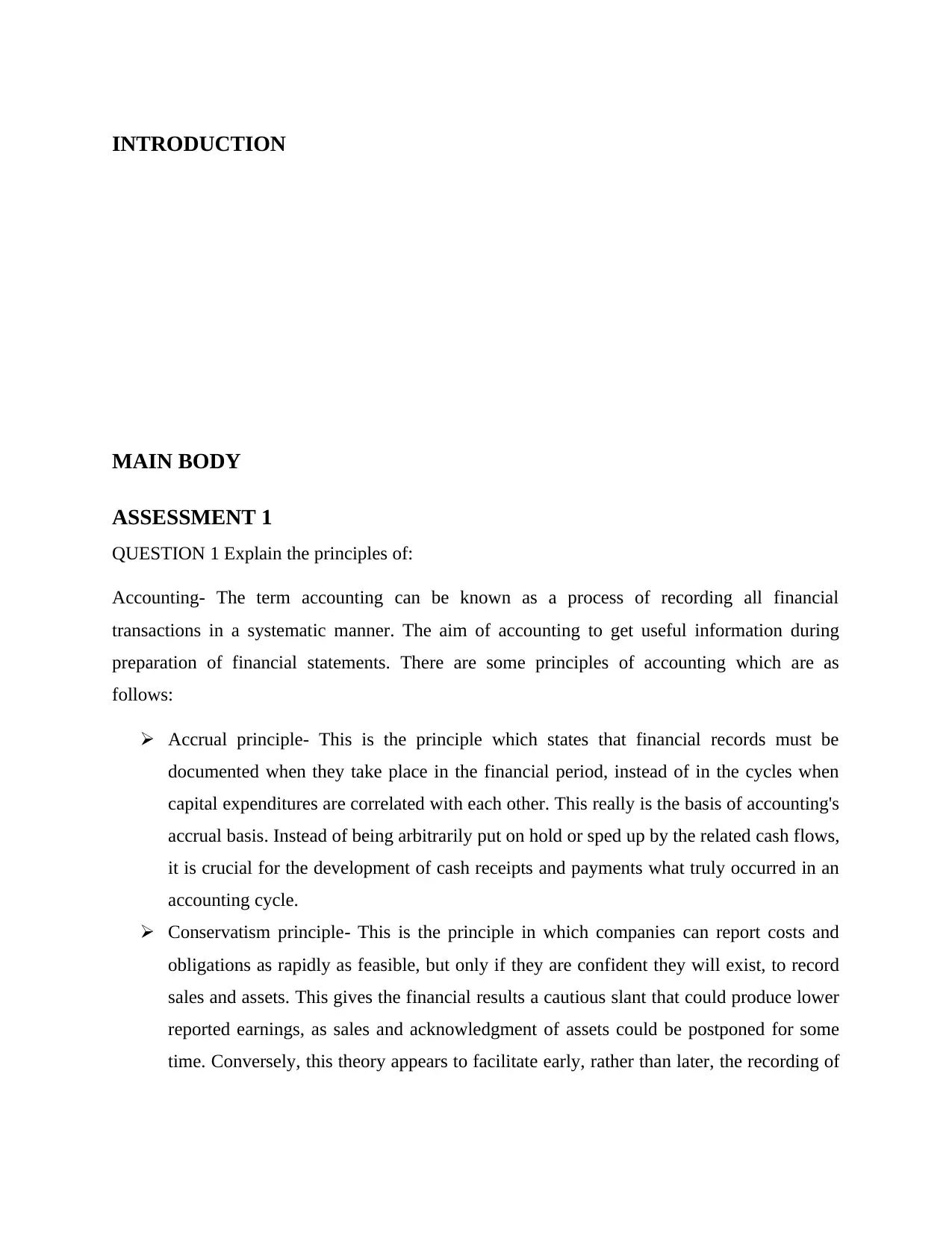
INTRODUCTION
MAIN BODY
ASSESSMENT 1
QUESTION 1 Explain the principles of:
Accounting- The term accounting can be known as a process of recording all financial
transactions in a systematic manner. The aim of accounting to get useful information during
preparation of financial statements. There are some principles of accounting which are as
follows:
Accrual principle- This is the principle which states that financial records must be
documented when they take place in the financial period, instead of in the cycles when
capital expenditures are correlated with each other. This really is the basis of accounting's
accrual basis. Instead of being arbitrarily put on hold or sped up by the related cash flows,
it is crucial for the development of cash receipts and payments what truly occurred in an
accounting cycle.
Conservatism principle- This is the principle in which companies can report costs and
obligations as rapidly as feasible, but only if they are confident they will exist, to record
sales and assets. This gives the financial results a cautious slant that could produce lower
reported earnings, as sales and acknowledgment of assets could be postponed for some
time. Conversely, this theory appears to facilitate early, rather than later, the recording of
MAIN BODY
ASSESSMENT 1
QUESTION 1 Explain the principles of:
Accounting- The term accounting can be known as a process of recording all financial
transactions in a systematic manner. The aim of accounting to get useful information during
preparation of financial statements. There are some principles of accounting which are as
follows:
Accrual principle- This is the principle which states that financial records must be
documented when they take place in the financial period, instead of in the cycles when
capital expenditures are correlated with each other. This really is the basis of accounting's
accrual basis. Instead of being arbitrarily put on hold or sped up by the related cash flows,
it is crucial for the development of cash receipts and payments what truly occurred in an
accounting cycle.
Conservatism principle- This is the principle in which companies can report costs and
obligations as rapidly as feasible, but only if they are confident they will exist, to record
sales and assets. This gives the financial results a cautious slant that could produce lower
reported earnings, as sales and acknowledgment of assets could be postponed for some
time. Conversely, this theory appears to facilitate early, rather than later, the recording of
⊘ This is a preview!⊘
Do you want full access?
Subscribe today to unlock all pages.

Trusted by 1+ million students worldwide
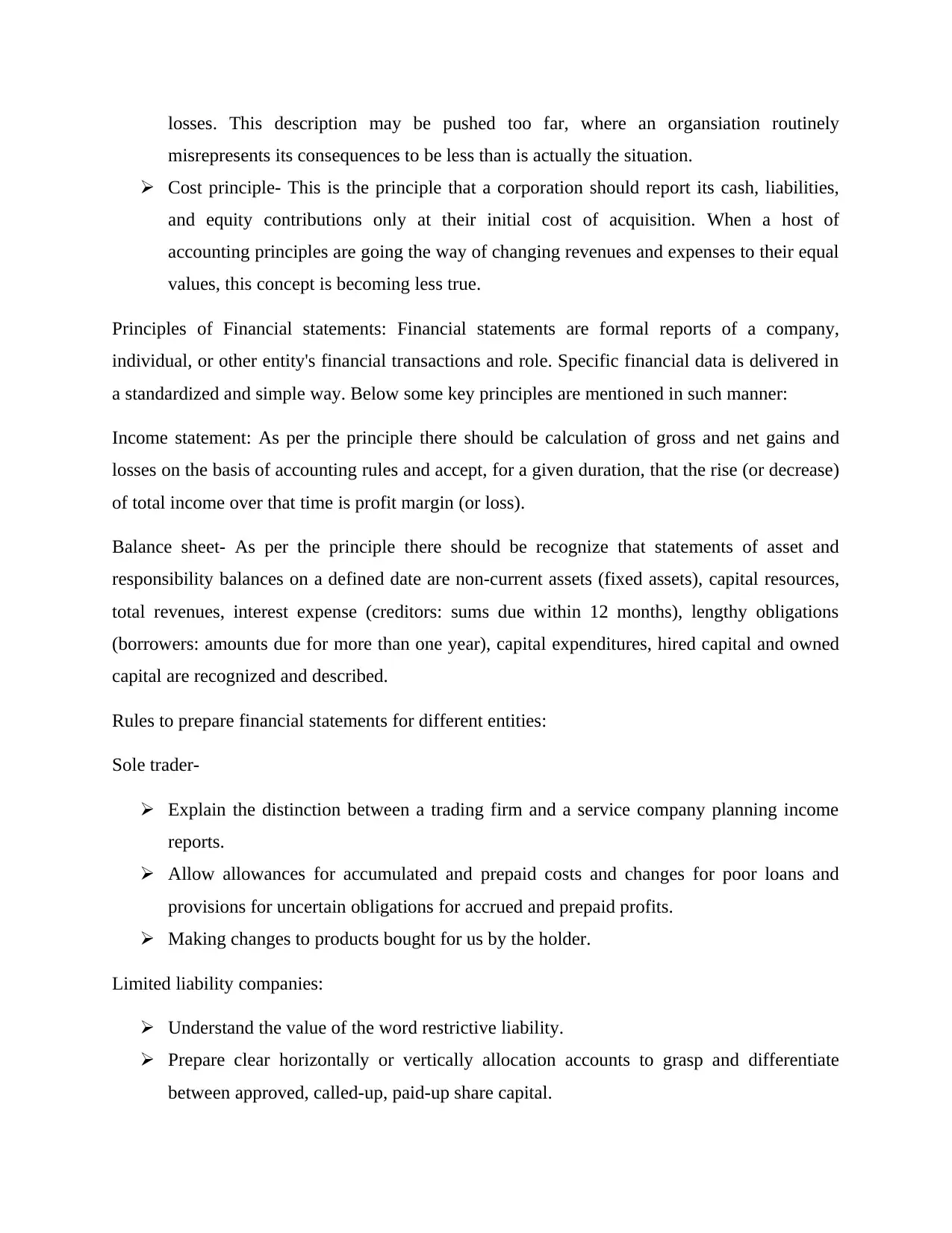
losses. This description may be pushed too far, where an organsiation routinely
misrepresents its consequences to be less than is actually the situation.
Cost principle- This is the principle that a corporation should report its cash, liabilities,
and equity contributions only at their initial cost of acquisition. When a host of
accounting principles are going the way of changing revenues and expenses to their equal
values, this concept is becoming less true.
Principles of Financial statements: Financial statements are formal reports of a company,
individual, or other entity's financial transactions and role. Specific financial data is delivered in
a standardized and simple way. Below some key principles are mentioned in such manner:
Income statement: As per the principle there should be calculation of gross and net gains and
losses on the basis of accounting rules and accept, for a given duration, that the rise (or decrease)
of total income over that time is profit margin (or loss).
Balance sheet- As per the principle there should be recognize that statements of asset and
responsibility balances on a defined date are non-current assets (fixed assets), capital resources,
total revenues, interest expense (creditors: sums due within 12 months), lengthy obligations
(borrowers: amounts due for more than one year), capital expenditures, hired capital and owned
capital are recognized and described.
Rules to prepare financial statements for different entities:
Sole trader-
Explain the distinction between a trading firm and a service company planning income
reports.
Allow allowances for accumulated and prepaid costs and changes for poor loans and
provisions for uncertain obligations for accrued and prepaid profits.
Making changes to products bought for us by the holder.
Limited liability companies:
Understand the value of the word restrictive liability.
Prepare clear horizontally or vertically allocation accounts to grasp and differentiate
between approved, called-up, paid-up share capital.
misrepresents its consequences to be less than is actually the situation.
Cost principle- This is the principle that a corporation should report its cash, liabilities,
and equity contributions only at their initial cost of acquisition. When a host of
accounting principles are going the way of changing revenues and expenses to their equal
values, this concept is becoming less true.
Principles of Financial statements: Financial statements are formal reports of a company,
individual, or other entity's financial transactions and role. Specific financial data is delivered in
a standardized and simple way. Below some key principles are mentioned in such manner:
Income statement: As per the principle there should be calculation of gross and net gains and
losses on the basis of accounting rules and accept, for a given duration, that the rise (or decrease)
of total income over that time is profit margin (or loss).
Balance sheet- As per the principle there should be recognize that statements of asset and
responsibility balances on a defined date are non-current assets (fixed assets), capital resources,
total revenues, interest expense (creditors: sums due within 12 months), lengthy obligations
(borrowers: amounts due for more than one year), capital expenditures, hired capital and owned
capital are recognized and described.
Rules to prepare financial statements for different entities:
Sole trader-
Explain the distinction between a trading firm and a service company planning income
reports.
Allow allowances for accumulated and prepaid costs and changes for poor loans and
provisions for uncertain obligations for accrued and prepaid profits.
Making changes to products bought for us by the holder.
Limited liability companies:
Understand the value of the word restrictive liability.
Prepare clear horizontally or vertically allocation accounts to grasp and differentiate
between approved, called-up, paid-up share capital.
Paraphrase This Document
Need a fresh take? Get an instant paraphrase of this document with our AI Paraphraser
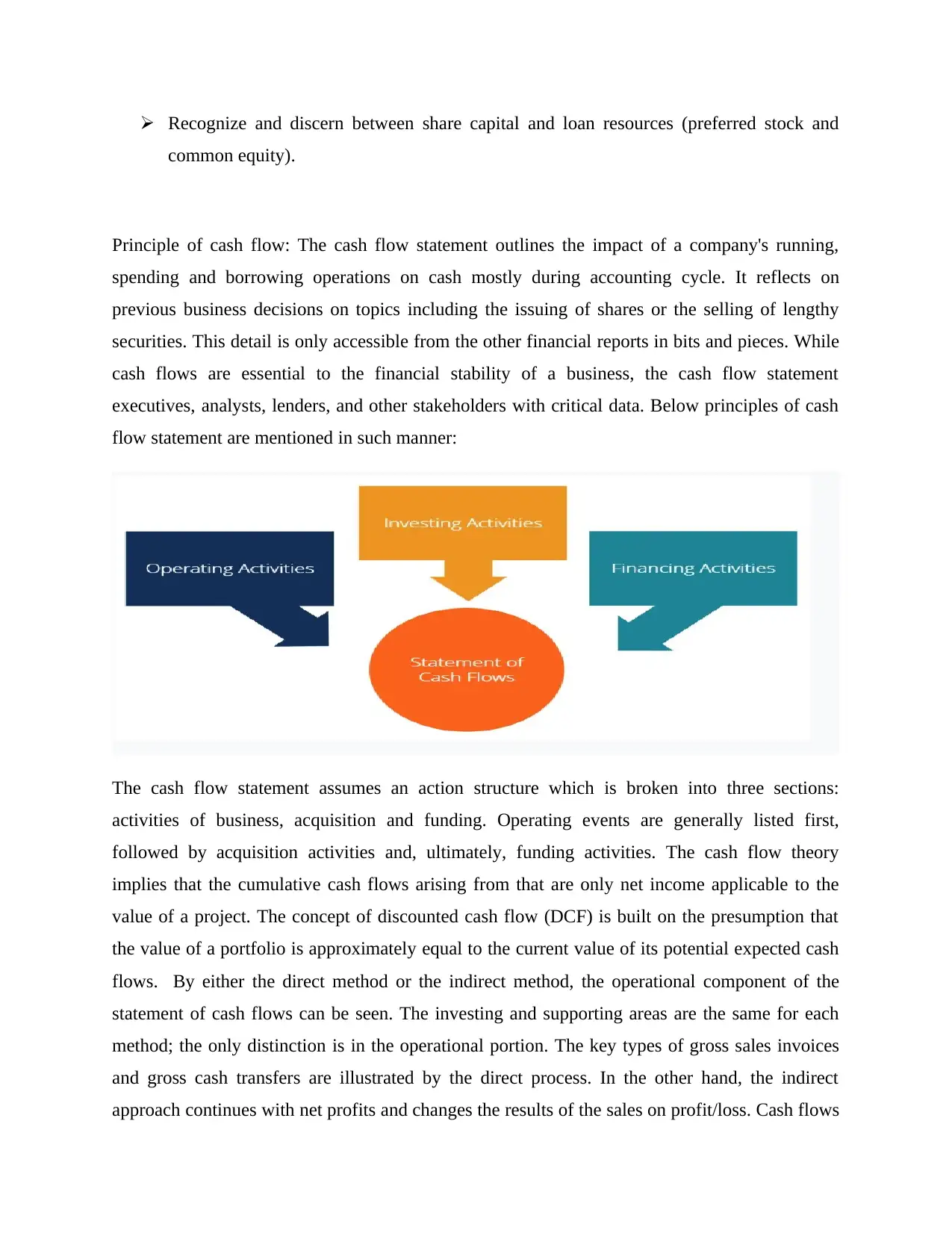
Recognize and discern between share capital and loan resources (preferred stock and
common equity).
Principle of cash flow: The cash flow statement outlines the impact of a company's running,
spending and borrowing operations on cash mostly during accounting cycle. It reflects on
previous business decisions on topics including the issuing of shares or the selling of lengthy
securities. This detail is only accessible from the other financial reports in bits and pieces. While
cash flows are essential to the financial stability of a business, the cash flow statement
executives, analysts, lenders, and other stakeholders with critical data. Below principles of cash
flow statement are mentioned in such manner:
The cash flow statement assumes an action structure which is broken into three sections:
activities of business, acquisition and funding. Operating events are generally listed first,
followed by acquisition activities and, ultimately, funding activities. The cash flow theory
implies that the cumulative cash flows arising from that are only net income applicable to the
value of a project. The concept of discounted cash flow (DCF) is built on the presumption that
the value of a portfolio is approximately equal to the current value of its potential expected cash
flows. By either the direct method or the indirect method, the operational component of the
statement of cash flows can be seen. The investing and supporting areas are the same for each
method; the only distinction is in the operational portion. The key types of gross sales invoices
and gross cash transfers are illustrated by the direct process. In the other hand, the indirect
approach continues with net profits and changes the results of the sales on profit/loss. Cash flows
common equity).
Principle of cash flow: The cash flow statement outlines the impact of a company's running,
spending and borrowing operations on cash mostly during accounting cycle. It reflects on
previous business decisions on topics including the issuing of shares or the selling of lengthy
securities. This detail is only accessible from the other financial reports in bits and pieces. While
cash flows are essential to the financial stability of a business, the cash flow statement
executives, analysts, lenders, and other stakeholders with critical data. Below principles of cash
flow statement are mentioned in such manner:
The cash flow statement assumes an action structure which is broken into three sections:
activities of business, acquisition and funding. Operating events are generally listed first,
followed by acquisition activities and, ultimately, funding activities. The cash flow theory
implies that the cumulative cash flows arising from that are only net income applicable to the
value of a project. The concept of discounted cash flow (DCF) is built on the presumption that
the value of a portfolio is approximately equal to the current value of its potential expected cash
flows. By either the direct method or the indirect method, the operational component of the
statement of cash flows can be seen. The investing and supporting areas are the same for each
method; the only distinction is in the operational portion. The key types of gross sales invoices
and gross cash transfers are illustrated by the direct process. In the other hand, the indirect
approach continues with net profits and changes the results of the sales on profit/loss. Cash flows
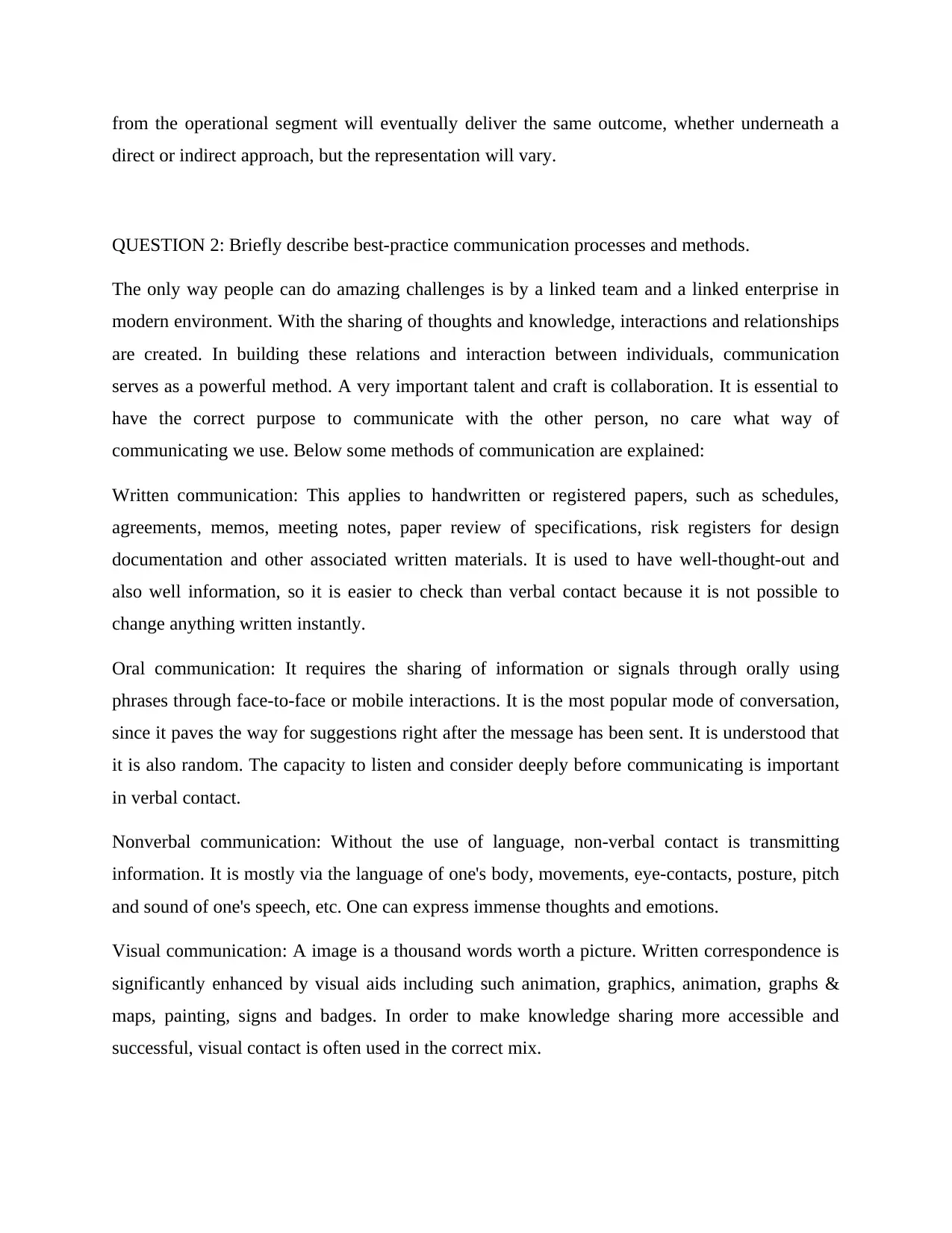
from the operational segment will eventually deliver the same outcome, whether underneath a
direct or indirect approach, but the representation will vary.
QUESTION 2: Briefly describe best-practice communication processes and methods.
The only way people can do amazing challenges is by a linked team and a linked enterprise in
modern environment. With the sharing of thoughts and knowledge, interactions and relationships
are created. In building these relations and interaction between individuals, communication
serves as a powerful method. A very important talent and craft is collaboration. It is essential to
have the correct purpose to communicate with the other person, no care what way of
communicating we use. Below some methods of communication are explained:
Written communication: This applies to handwritten or registered papers, such as schedules,
agreements, memos, meeting notes, paper review of specifications, risk registers for design
documentation and other associated written materials. It is used to have well-thought-out and
also well information, so it is easier to check than verbal contact because it is not possible to
change anything written instantly.
Oral communication: It requires the sharing of information or signals through orally using
phrases through face-to-face or mobile interactions. It is the most popular mode of conversation,
since it paves the way for suggestions right after the message has been sent. It is understood that
it is also random. The capacity to listen and consider deeply before communicating is important
in verbal contact.
Nonverbal communication: Without the use of language, non-verbal contact is transmitting
information. It is mostly via the language of one's body, movements, eye-contacts, posture, pitch
and sound of one's speech, etc. One can express immense thoughts and emotions.
Visual communication: A image is a thousand words worth a picture. Written correspondence is
significantly enhanced by visual aids including such animation, graphics, animation, graphs &
maps, painting, signs and badges. In order to make knowledge sharing more accessible and
successful, visual contact is often used in the correct mix.
direct or indirect approach, but the representation will vary.
QUESTION 2: Briefly describe best-practice communication processes and methods.
The only way people can do amazing challenges is by a linked team and a linked enterprise in
modern environment. With the sharing of thoughts and knowledge, interactions and relationships
are created. In building these relations and interaction between individuals, communication
serves as a powerful method. A very important talent and craft is collaboration. It is essential to
have the correct purpose to communicate with the other person, no care what way of
communicating we use. Below some methods of communication are explained:
Written communication: This applies to handwritten or registered papers, such as schedules,
agreements, memos, meeting notes, paper review of specifications, risk registers for design
documentation and other associated written materials. It is used to have well-thought-out and
also well information, so it is easier to check than verbal contact because it is not possible to
change anything written instantly.
Oral communication: It requires the sharing of information or signals through orally using
phrases through face-to-face or mobile interactions. It is the most popular mode of conversation,
since it paves the way for suggestions right after the message has been sent. It is understood that
it is also random. The capacity to listen and consider deeply before communicating is important
in verbal contact.
Nonverbal communication: Without the use of language, non-verbal contact is transmitting
information. It is mostly via the language of one's body, movements, eye-contacts, posture, pitch
and sound of one's speech, etc. One can express immense thoughts and emotions.
Visual communication: A image is a thousand words worth a picture. Written correspondence is
significantly enhanced by visual aids including such animation, graphics, animation, graphs &
maps, painting, signs and badges. In order to make knowledge sharing more accessible and
successful, visual contact is often used in the correct mix.
⊘ This is a preview!⊘
Do you want full access?
Subscribe today to unlock all pages.

Trusted by 1+ million students worldwide
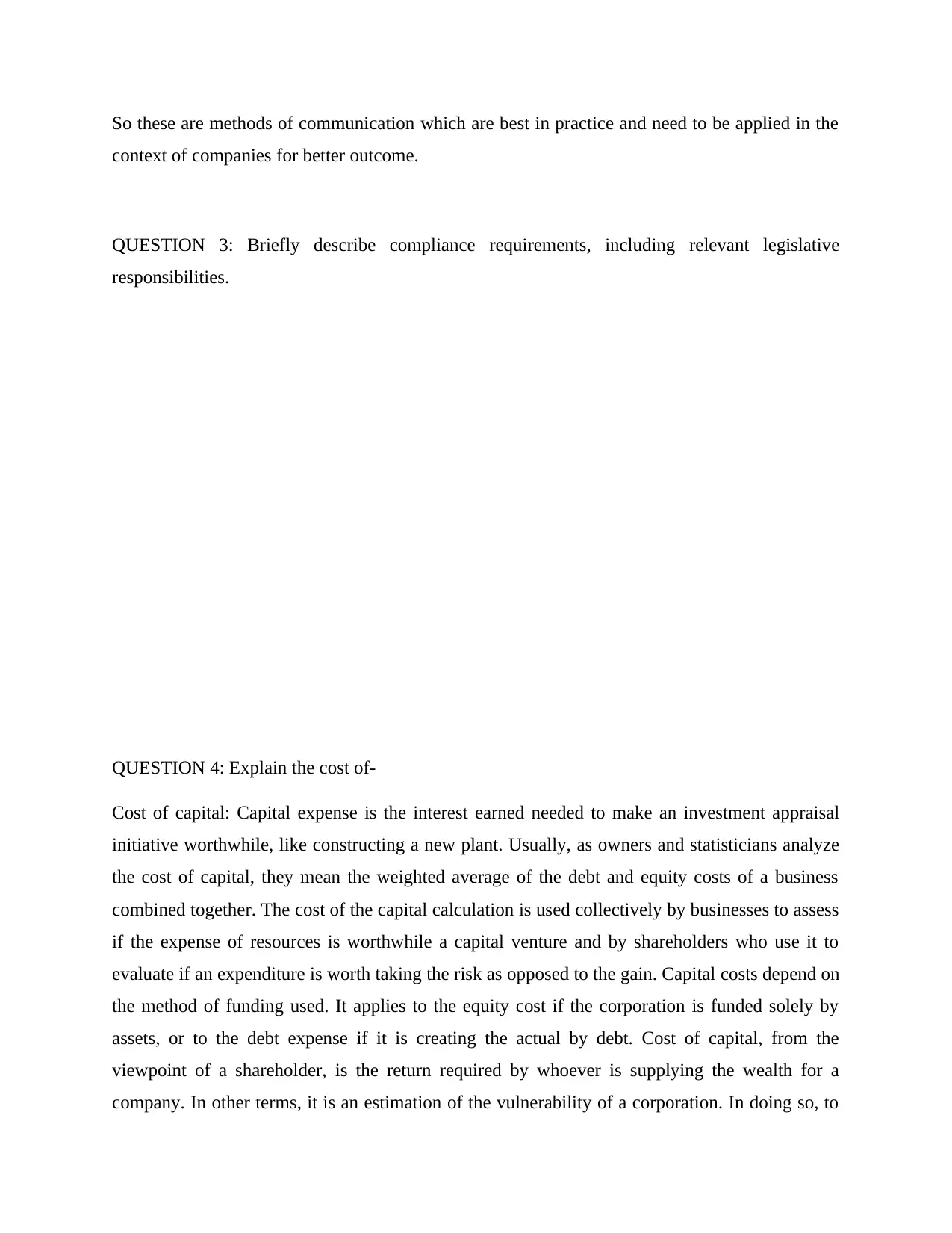
So these are methods of communication which are best in practice and need to be applied in the
context of companies for better outcome.
QUESTION 3: Briefly describe compliance requirements, including relevant legislative
responsibilities.
QUESTION 4: Explain the cost of-
Cost of capital: Capital expense is the interest earned needed to make an investment appraisal
initiative worthwhile, like constructing a new plant. Usually, as owners and statisticians analyze
the cost of capital, they mean the weighted average of the debt and equity costs of a business
combined together. The cost of the capital calculation is used collectively by businesses to assess
if the expense of resources is worthwhile a capital venture and by shareholders who use it to
evaluate if an expenditure is worth taking the risk as opposed to the gain. Capital costs depend on
the method of funding used. It applies to the equity cost if the corporation is funded solely by
assets, or to the debt expense if it is creating the actual by debt. Cost of capital, from the
viewpoint of a shareholder, is the return required by whoever is supplying the wealth for a
company. In other terms, it is an estimation of the vulnerability of a corporation. In doing so, to
context of companies for better outcome.
QUESTION 3: Briefly describe compliance requirements, including relevant legislative
responsibilities.
QUESTION 4: Explain the cost of-
Cost of capital: Capital expense is the interest earned needed to make an investment appraisal
initiative worthwhile, like constructing a new plant. Usually, as owners and statisticians analyze
the cost of capital, they mean the weighted average of the debt and equity costs of a business
combined together. The cost of the capital calculation is used collectively by businesses to assess
if the expense of resources is worthwhile a capital venture and by shareholders who use it to
evaluate if an expenditure is worth taking the risk as opposed to the gain. Capital costs depend on
the method of funding used. It applies to the equity cost if the corporation is funded solely by
assets, or to the debt expense if it is creating the actual by debt. Cost of capital, from the
viewpoint of a shareholder, is the return required by whoever is supplying the wealth for a
company. In other terms, it is an estimation of the vulnerability of a corporation. In doing so, to
Paraphrase This Document
Need a fresh take? Get an instant paraphrase of this document with our AI Paraphraser
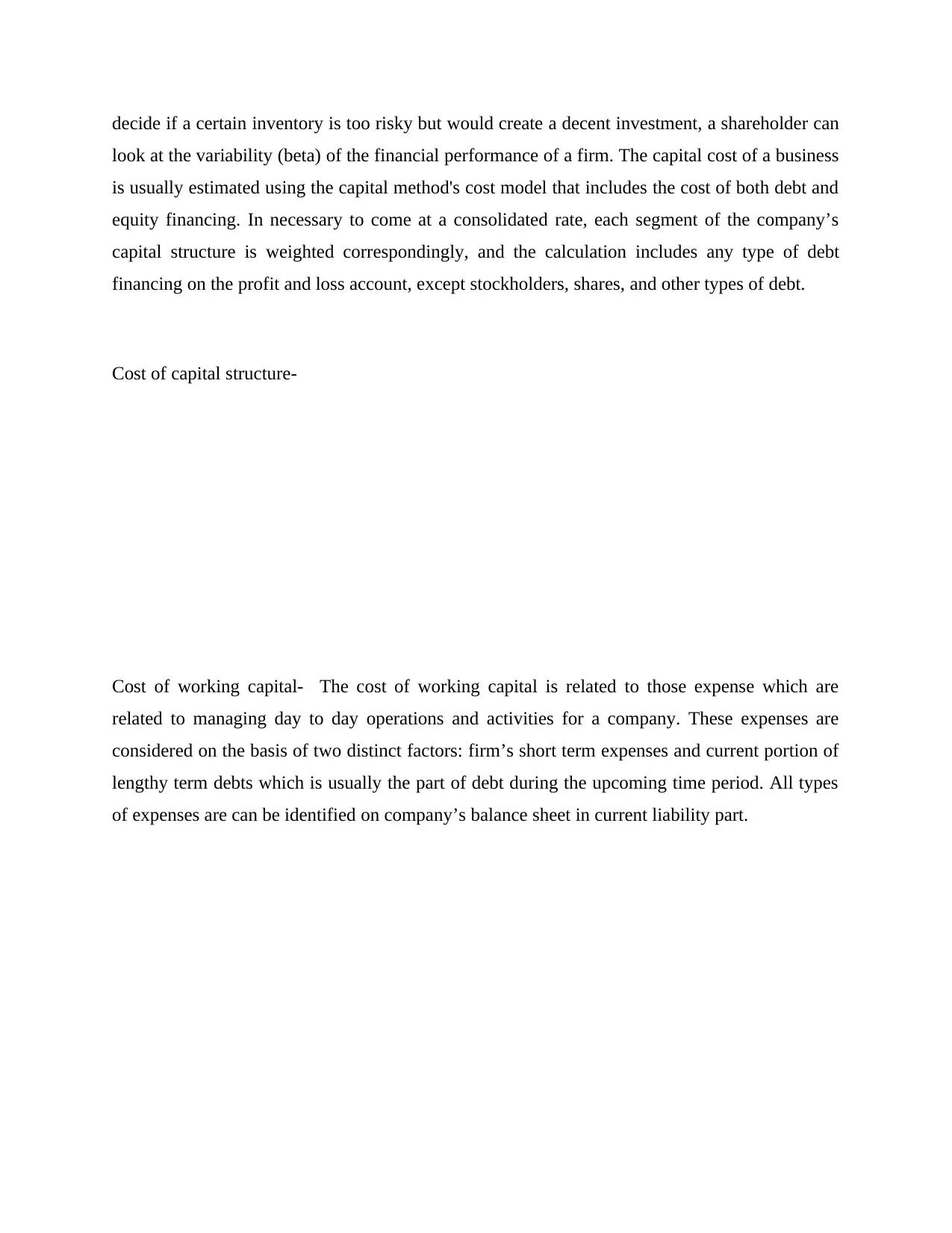
decide if a certain inventory is too risky but would create a decent investment, a shareholder can
look at the variability (beta) of the financial performance of a firm. The capital cost of a business
is usually estimated using the capital method's cost model that includes the cost of both debt and
equity financing. In necessary to come at a consolidated rate, each segment of the company’s
capital structure is weighted correspondingly, and the calculation includes any type of debt
financing on the profit and loss account, except stockholders, shares, and other types of debt.
Cost of capital structure-
Cost of working capital- The cost of working capital is related to those expense which are
related to managing day to day operations and activities for a company. These expenses are
considered on the basis of two distinct factors: firm’s short term expenses and current portion of
lengthy term debts which is usually the part of debt during the upcoming time period. All types
of expenses are can be identified on company’s balance sheet in current liability part.
look at the variability (beta) of the financial performance of a firm. The capital cost of a business
is usually estimated using the capital method's cost model that includes the cost of both debt and
equity financing. In necessary to come at a consolidated rate, each segment of the company’s
capital structure is weighted correspondingly, and the calculation includes any type of debt
financing on the profit and loss account, except stockholders, shares, and other types of debt.
Cost of capital structure-
Cost of working capital- The cost of working capital is related to those expense which are
related to managing day to day operations and activities for a company. These expenses are
considered on the basis of two distinct factors: firm’s short term expenses and current portion of
lengthy term debts which is usually the part of debt during the upcoming time period. All types
of expenses are can be identified on company’s balance sheet in current liability part.
1 out of 8
Related Documents
Your All-in-One AI-Powered Toolkit for Academic Success.
+13062052269
info@desklib.com
Available 24*7 on WhatsApp / Email
![[object Object]](/_next/static/media/star-bottom.7253800d.svg)
Unlock your academic potential
Copyright © 2020–2025 A2Z Services. All Rights Reserved. Developed and managed by ZUCOL.





